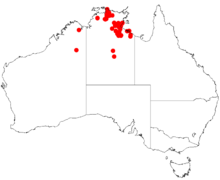Acacia conspersa
| Acacia conspersa | |
|---|---|
| Scientific classification | |
| Kingdom: | Plantae |
| Clade: | Tracheophytes |
| Clade: | Angiosperms |
| Clade: | Eudicots |
| Clade: | Rosids |
| Order: | Fabales |
| Family: | Fabaceae |
| Subfamily: | Caesalpinioideae |
| Clade: | Mimosoid clade |
| Genus: | Acacia |
| Species: | A. conspersa
|
| Binomial name | |
| Acacia conspersa | |

| |
| Occurrence data from AVH | |
Acacia conspersa is a shrub or tree belonging to the genus Acacia and the subgenus Juliflorae that is native to northern Australia.
Description[edit]
The shrub or tree that typically grows a height of around 1.5 m (4 ft 11 in)[1] and to a maximum height of 7.5 m (25 ft)[2] and has an open to slightly pendulous habit.[1] It has brown to grey coloured bark that is rough and stringy or longitudinally fissured. It has terete branchlets that are densely villous. Like most species of Acacia it has phyllodes instead of true leaves. The evergreen and coriaceous phyllodes are often covered in scale and have a narrowly elliptic to linear shape and are straight to subfalcate. they have a length of 3.5 to 8.5 cm (1.4 to 3.3 in) and a width of 4 to 12 mm (0.16 to 0.47 in) and have a prominent midnerve and a single much less prominent nerve on either side. It blooms between April and October producing bright yellow flowers. The flowers are found on flower-spikes that are 3 to 4.5 mm (0.12 to 0.18 in) in length. Following flowering coriaceous, longitudinally striate and scurfy seed pods form that have a linear shape with a length of 4 to 13 cm (1.6 to 5.1 in) and a width of 3 to 5 mm (0.12 to 0.20 in) with longitudinally arranged seeds inside. The dark brown seeds have a length of 4.6 to 5.7 mm (0.18 to 0.22 in).[2]
Taxonomy[edit]
the species was first formally described by the botanist Ferdinand von Mueller in 1859 as part of the work Contributiones ad Acaciarum Australiae Cognitionem as published in the Journal of the Proceedings of the Linnean Society, Botany. It is easily confused with Acacia leptostachya.[3] The type specimen was collected by von Mueller in 1856 along the Gulf of Carpentaria.[2]
Distribution[edit]
It is endemic to tropical areas in the Northern Territory where it is usually situated along creeks, in gullies or on sandstone hills where it is often found in colonies growing in alluvium or stony sandy soils as a part of shrubland, savannah grassland, Eucalyptus woodland or wet forest communities.[2]
See also[edit]
References[edit]
- ^ a b "Acacia conspersa". Wattles -Genus Acacia. Australian National Herbarium. Retrieved 8 October 2019.
- ^ a b c d "Acacia conspersa". WorldWideWattle. Western Australian Herbarium. Retrieved 7 October 2019.
- ^ "Acacia conspersa F.Muell. (misapplied to Acacia leptostachya)". Atlas of Living Australia. Global Biodiversity Information Facility. Retrieved 8 October 2019.
